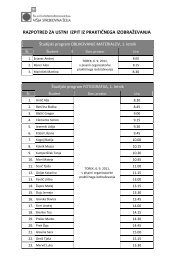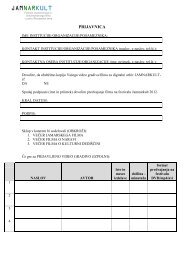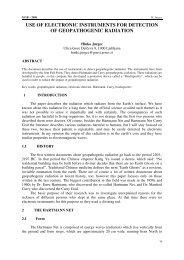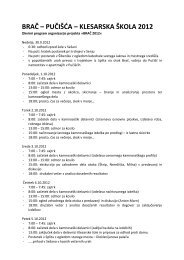MODERN FLUX-GATE MAGNETOMETERS DESIGN
MODERN FLUX-GATE MAGNETOMETERS DESIGN
MODERN FLUX-GATE MAGNETOMETERS DESIGN
Create successful ePaper yourself
Turn your PDF publications into a flip-book with our unique Google optimized e-Paper software.
MGB – 2008<br />
V. Korepanov, A. Marusenkov<br />
<strong>MODERN</strong> <strong>FLUX</strong>-<strong>GATE</strong> <strong>MAGNETOMETERS</strong> <strong>DESIGN</strong><br />
ABSTRACT<br />
Valery Korepanov, Andriy Marusenkov<br />
Lviv Centre of Institute for Space Research<br />
5A Naukova Str., 79000 Lviv, Ukraine<br />
vakor@ isr.lviv.ua, marand@isr.lviv.ua<br />
The most important metrological parameters of the flux-gate magnetometers - noise level, thermal drift, longterm<br />
stability - are considered. The ways of their improvement are analysed and some results of experimental<br />
investigation of the upgraded magnetometers are presented.<br />
Keywords: flux-gate, magnetometer, sensor, noise, excitation, temperature<br />
1 INTRODUCTION<br />
The last years the tendency to miniaturize the flux-gate sensors (FGS) and to improve<br />
their parameters repeatability by the shift of the manufacturing technology to the microchip or<br />
printed circuit board (PCB) level is clearly observed [1, 2, 3]. Simultaneously, it is commonly<br />
accepted that their parameters dramatically degrade when reducing the core size. Hence such<br />
way automatically puts the fluxgate sensors into the zone, where other types of the magnetic<br />
sensors, such as magnetoimpedance, anisotropic and giant magnetoresitive and even Hall<br />
effects based ones have similar metrological characteristics and cover the same range of<br />
consumer applications. Another aspect is the power consumption. As it has been shown [4]<br />
the consumed power necessary for the sensor excitation mainly originates from the losses in<br />
the excitation coil. So, the use of the PCB or microchip coil instead of the wire one gives us a<br />
priori worse ratio between the metrological parameters and the power consumption at the<br />
same magnetic core. In spite of some progress in the technology and theory of the PCB or<br />
microchip based flux-gate sensors it may hardly be expected that in the nearest future their<br />
metrological parameters reach the level of the FGS based on the traditional technology.<br />
That is why we continue to apply our efforts in modernization of the high sensitive<br />
fluxgate magnetometers with traditional structure. If to range the metrological parameters of<br />
such magnetometers for measuring weak magnetic field according to their importance at<br />
practical use, the sequence will be the following:<br />
- noise level;<br />
- thermal drift;<br />
- long-term stability;<br />
- all other parameters.<br />
We are going to consider in this paper some possibilities of improvement of first three<br />
parameters.<br />
A practice of flux-gate magnetometers (FGM) development and manufacturing shows<br />
that the level of their principal characteristics directly depends on the properties of the<br />
material from which both flux-gate sensor core housing and its components are produced.<br />
Also modern requirements to the reduction of sensors dimensions, their energy losses and<br />
noise level are mutually excluding ones and all of them first of all depend on the FGS core<br />
material quality and its excitation conditions. The thermal stability in the relatively large<br />
magnetic field includes such aspects as stability of the compensation field and orientation of<br />
the sensor axes. The both problems require using in the compensation windings frame the<br />
31
MGB – 2008<br />
V. Korepanov, A. Marusenkov<br />
highest possible quality materials with low linear expansion coefficient and perfect long-term<br />
stability of their physical dimensions. Some results of using such materials as glass-ceramic<br />
(Zerodur® and Macor®) and quartz ceramic are discussed in the paper. These postulates<br />
trustworthiness is demonstrated in the report.<br />
2 FGM PARAMETERS IMPROVEMENT<br />
2.1 Noise level<br />
If to consider the sources of the mentioned errors in detail one can find that noise level<br />
and zero offset stability are limited mainly by the quality of the sensor magnetic core and its<br />
excitation mode parameters. Due to the variety of the magnetic core geometry of the flux-gate<br />
sensors (ring-core, racetrack, bar-core etc), their excitation modes and the methods of<br />
measured signal extraction, the comparison of the different sensor by the noise level is not an<br />
easy task. For the modern magnetometers the main part of their noise is caused by the<br />
fluctuations of the Barkhausen jumps parameters during cyclic magnetization reversals of the<br />
sensor core. There are following directions for decreasing noise level of the flux-gate sensors:<br />
- Developing of the new magnetic materials with increased uniformity of the<br />
Barkhausen jumps, mainly amorphous alloys [5, 6] or single domain materials as an<br />
yttrium iron garnet [7] or specially prepared magnetic alloys [8, 9].<br />
- Increasing of the magnetic core volume [10], optimization of both its geometry [11,<br />
12] and excitation mode [10, 13].<br />
- Using the effect of the magnetic noise decreasing at the magnetic core operation close<br />
to the Curie point [5, 14, 15].<br />
Investigations conducted in LC ISR reveal that racetrack, ring-core and bar-core<br />
geometry of the flux-gate sensors could provide approximately equal noise level at the same<br />
volume of the magnetic core, in contradistinction with commonly accepted opinion that ringcores<br />
have the advantage over other core structures. Practically, taking into account<br />
secondary, but important factors (e.g., inter-layers friction and vibration, tape inhomogeneity,<br />
possibility of the magnetic tape pre-selection etc.) the bar-core geometry allowed us to get<br />
lower noise level as ring-cores or race-track ones.<br />
As it was shown [16], the spectral density of the magnetic noise power is inversely<br />
proportional to the magnetic core volume, if the additional noise sources such as winding<br />
defects, mechanical stresses and so on are suppressed. In order to achieve this conclusion the<br />
topologically similar in geometry cores with different volume of ferromagnetic material and<br />
made in each set from the same batch of material with a common heat treatment and identical<br />
shape and amplitude of excitation field were studied. The derived dependency allowed us to<br />
propose to use the introduced parameter C B − noise spectral density referred to core volume −<br />
for the convenient comparison of the magnetic materials. The values of this parameter (Table<br />
1) for the best magnetic materials were calculated using data from the papers [10, 17, 18] and<br />
investigations results carried out in LS ISR.<br />
Also the sensor units with cores of different materials from different producers have<br />
been tested. Unfortunately, it was not always possible to achieve the repetition of product<br />
performances; in most cases, it was necessary to adjust the circuits in accordance with given<br />
sensor parameters.<br />
32
MGB – 2008<br />
V. Korepanov, A. Marusenkov<br />
Table 1: Comparison of the magnetic material by the noise level<br />
Magnetic material C B ⋅10 15 , T⋅m 3/2 ⋅Hz -1/2<br />
Permalloy (Ni 83 Fe 11 ) [10] 0.8<br />
Mo-Permalloy (Ni 81 Mo 6 ) [17] 0.23<br />
Vitrovac6025 (stress annealed) [18] 0.36<br />
Co 68 Fe 3 Cr 3 Si 15 B 12 (annealed in the<br />
longitudinal magnetic field, LC ISR)<br />
0.2…0.36<br />
The continuous study of the materials properties for FGM sensors have allowed<br />
developing a new version of processing technology of such materials and to reach the stable<br />
repetition of the processing results. As far as the process of the production of metal tape of an<br />
alloy of necessary composition as basic material is very complicated and requires<br />
corresponding specialized high-cost equipment, a decision was made to concentrate efforts at<br />
the final processing of amorphous materials as the most promising direction. As such a<br />
processing the annealing at the certain temperature conditions with usage of several additional<br />
factors influencing the annealing mode (magnetic field, medium of inert gas, mechanical<br />
stresses, etc) was selected. At that such FGS parameter as its own noise level at the core<br />
operation inside the sensor was determined as the selection criterion. Measurements of the<br />
noise level have been carried out using second harmonic of excitation frequency as an<br />
information parameter. In the results the reducing of the noise level from 3 to more than 10<br />
times was achieved for different types of amorphous magnetic material.<br />
The details of the study are exposed in the report and experimental results confirming<br />
the theoretical calculations are given.<br />
2.2 Excitation mode selection<br />
It is well known for the skilful in the art that the properly selected excitation mode of<br />
the FGS core may considerably improve the main FGM parameters. The peculiarities of<br />
different types of the excitation modes were thoroughly studied at the early stages of FGM<br />
development [19, 20] and a bit later a so called “ferroresonance excitation mode” (FEM) was<br />
proposed as optimal one [21]. The peculiarity of FEM was the use of the non-linearity of the<br />
ferromagnetic resonance circuit when the impedance of the coil L e with high permeability<br />
ferromagnetic core differs in many times during the periods of the saturated and non-saturated<br />
states of this core (the simplest circuit realizing FEM and the plots of currents and voltages in<br />
this mode are given in Figure 1). By this the excitation i g current has sinusoidal shape what<br />
made it much easier to damp the second harmonic of the excitation current source frequency,<br />
and the excitation voltage u e has the shape very close to the rectangular one, which was<br />
generally accepted as the best possible [20] to reduce the FGS noise. The ability to provide<br />
the strong excitation field makes FEM suitable for sensors which should withstand an<br />
overload by great magnetic field. The perming error − the zero offset after overload - is very<br />
small for sensors operated in FEM. The peculiarities of the possible FGS excitation modes are<br />
summarized in the Table 2. As it is clearly seen from the table, FEM provides the best<br />
combination of the excitation parameters.<br />
33
MGB – 2008<br />
V. Korepanov, A. Marusenkov<br />
0<br />
a) b)<br />
Figure 1: a – the circuit for realizing of FEM;<br />
b – the plots of the currents and voltages during FEM.<br />
Table 2. Comparison of the FGS excitation modes<br />
Excitation mode<br />
Current (shape) Voltage (shape)<br />
Parameter<br />
sinusoidal<br />
triangular<br />
trapezoidal<br />
step-wise<br />
rectangular<br />
sinusoidal<br />
triangular<br />
FEM<br />
Sensitivity threshold + 0 0 0 ++ + ++<br />
Even harmonic error + 0 0 0 ++ + ++<br />
Generator voltage changes error + + + ++ 0 0 ++<br />
Perming error 0 0 0 + + + ++<br />
Sensitivity stability 0 0 0 ++ + + ++<br />
Rapidity + + 0 0 ++ ++ ++<br />
Self-heating of FGS 0 0 0 0 + + ++<br />
Realization simplicity ++ + 0 0 ++ ++ +<br />
Analysis and calculation simplicity ++ ++ ++ ++ 0 + 0<br />
Notes 0 – unsatisfactory value of the parameter;<br />
+ – satisfactory value of the parameter;<br />
++ – good value of the parameter.<br />
2.3 FGM thermal stability<br />
As it was already mentioned upper, the FGM zero line stability with changing<br />
temperature may be provided, first, by the appropriate material selection for the construction<br />
of FGS housing and its components. As it may be shown, the very small tilts of FGS axes<br />
may produce considerable shifts of its output signals. So, first requirement to the sensor<br />
housing material is as low as possible factor of thermal expansion. One of the best known<br />
results gives the combination of the sensor housing manufacturing from marble and the<br />
compensation winding frame for each component – from quartz. Such FGS construction was<br />
proposed by O. Rasmussen [22] and many years successfully used in the observatory<br />
34
MGB – 2008<br />
V. Korepanov, A. Marusenkov<br />
magnetometers. But the raise of the requirements to the thermal stability of modern FGMs,<br />
especially for field use, stimulated new research in this direction. First improvement was<br />
obtained with the help of using of a specific glass-ceramic having thermal expansion factor<br />
below 10 -6 in the FGS operation temperature range (-40 ÷ +40 ºC). But still one factor – nonuniformity<br />
of the compensation field – did not allow further decreasing of the FGM thermal<br />
drift as it is required today – below 0.1 nT per ºC. For space magnetometers this problem was<br />
competed by using a spherical construction of the compensation winding frame [23], which<br />
produces the highly uniform compensation field in the sensor volume. But rather high price of<br />
such a construction and technological difficulties of FGS manufacturing do not allow using it<br />
in the serially produced FGMs. The executed research showed more efficient way to decrease<br />
this component of the thermal drift. The main idea of the proposed approach is to optimize the<br />
shape of compensation field non-uniformity in such a way that the small deviations of the<br />
length or/and position of the FGS core have practically no influence on the value of the<br />
compensation field averaged by core length. The experimental investigations [24] reveal<br />
significant improvement of the scale factor stability of the magnetometer with optimized the<br />
shape of the compensation field (comparable with other shapes of non-uniformity) at the<br />
changes of the excitation field. Using this approach the new sensor with volume<br />
compensation, combining three dual rod cores in a Macor® cube with the side dimension of<br />
20 mm was created for the small magnetometer in low-mass experiment (SMILE) [25].<br />
Despite the short length of the fluxgate cores, the noise level was typically 20 pT/sqrt(Hz) at<br />
1 Hz and the non-orthogonality did not exceed 20 arc minute, and the values were stable in<br />
the whole range of the excitation currents. The temperature coefficient of the scale factor was<br />
below 10 ppm per °C, the angle stability was better than 3″ per °C. Using such an approach<br />
we hope to create an advanced fluxgate sensor for geophysical applications.<br />
3 CONCLUSIONS<br />
Basing on such detailed study of the ways to improve the FGS parameters, already<br />
during many years LC ISR managed to develop and manufacture of flux-gate magnetometers<br />
and equipment including them traceable to highest international standards. The requirement to<br />
decrease simultaneously “weight-consumption-noise” set of parameters was continuously<br />
kept in mind. With the specially produced and processed amorphous tape the set of the<br />
sensors was created with noise level about 2-5 pT/sqrt(Hz) and as low consumed power as<br />
MGB – 2008<br />
V. Korepanov, A. Marusenkov<br />
[6] O. V. Nielsen, Analysis of a fluxgate magnetometer based on metallic glass sensors,<br />
Meas. Sci. Technol., 2, 1991, pp. 435-440.<br />
[7] P. M. Vetoshko, V. V. Valeiko, P. I. Nikitin, Epitaxial yttrium iron garnet film as an<br />
active medium of an even-harmonic magnetic field transducer, Sensors and Actuators<br />
A, 106, 2003, pp. 270-273.<br />
[8] R. H. Koch, J. G. Deak, G. Grinstein, Fundamental limits to magnetic field sensitivity of<br />
flux-gate magnetic-field sensors, Applied Physics Letters, Vol. 75, 24, 1999, pp. 3862-<br />
3864.<br />
[9] R. H. Koch, J. R. Rozen, Low-noise flux-gate magnetic-field sensors using ring- and<br />
rod-core geometries, Applied Physics Letters, Vol. 78, 13, 1999, pp. 1897-1899.<br />
[10] R. Berkman, Theoretic and experimental investigation of flux-gate magnetometer noise,<br />
Proc. IMEKO-XV World Congress June 13-18, Osaka, Japan, 1999, pp. 149-156.<br />
[11] F. Primdahl et al, Demagnetising factor and noise in the fluxgate ring-core sensor,<br />
J. Phys. E: Sci. Instrum., 22, 1989, pp. 1004-1008.<br />
[12] C. Hinnrichs, J. Stahl, K. Kuchenbrandt, M. Schilling, Dependence of sensitivity and<br />
noise of fluxgate sensors on racetrack geometry, IEEE Trans. Magn., Vol. 37, 4, 2001,<br />
pp. 1983-1985.<br />
[13] E. Paperno, Suppression of magnetic noise in the fundamental-mode orthogonal<br />
fluxgate, Sensors and Actuators: A, Vol. 116, 2004, pp. 405-409.<br />
[14] M. P. Afanasenko, R. Ya. Berkman, Noise decreasing in the magnetic materials at the<br />
core operation close to the Curie point, Information extraction and processing, 48,<br />
1976, pp. 83-87 (in Russian).<br />
[15] N. N. Kolachevsky, Fluctuation processes in ferromagnetic materials, Nauka, Moscow,<br />
1985 (in Russian).<br />
[16] V. Korepanov, R. Berkman et al., Advanced field magnetometers comparative study,<br />
Measurement, 29, 2001, pp. 137-146.<br />
[17] Ringcores. Advertising materials of Magson GmbH, available on Internet in year 2008,<br />
URL: http://www.magson.de/pdf/ringcores.pdf.<br />
[18] C. Moldovanu et al, The noise of the Vacquier type sensors referred to changes of the<br />
sensor geometrical dimensions, Sensors and Actuators A, Vol. 81, 2000, pp. 197-199.<br />
[19] R. Ya. Berkman, R. E. Martyniuk-Lototsky, About similarity and important difference<br />
in the analysis of excitation conditions of magnetic modulators and flux-gates,<br />
Components of the systems of information reception and transmission, Naukova<br />
Dumka, Kyiv, 1965, pp. 95-103 (in Russian).<br />
[20] Yu.V. Afanasyev, Flux-gates instruments, Energoatomizdat, Leningrad, 1986, p. 90.<br />
[21] R. Ya. Berkman, B. L. Bondaruk, V. M. Fedotov, Ferroresonance excitation mode of<br />
the magnetic modulators and flux-gates, Geophysical Instrumentation, 50, 1972, pp. 20-<br />
28 (in Russian).<br />
[22] O. Rasmussen, E.K. Lauridsen, Improving baseline drift in fluxgate magnetometers<br />
caused by foundation movements, using band suspended fluxgate sensors, Phys. Earth<br />
Planet. Int., 59, 1990, pp 78-81.<br />
[23] F. Primdahl, A.P. Jensen, Compact spherical coil for flux-gate magnetometer vector<br />
feedback, J.Phys.E.: Sci. Instrum., 15, 1982, pp. 221-226.<br />
[24] A. Marusenkov, Operation peculiarities of the fluxgate sensor in non-uniform<br />
compensation magnetic field, Proc. of the IX th Int. Conf. Modern Problems of Radio<br />
Engineering, Telecommunications and Computer Science 2006, Lviv−Slavske,<br />
February 28 – March 4, 2006, pp. 327-329.<br />
[25] A. Forslund et al, Miniaturized digital fluxgate magnetometer for small spacecraft<br />
applications, Meas. Sci. Technol., 19, 2008, pp. 1-10.<br />
36


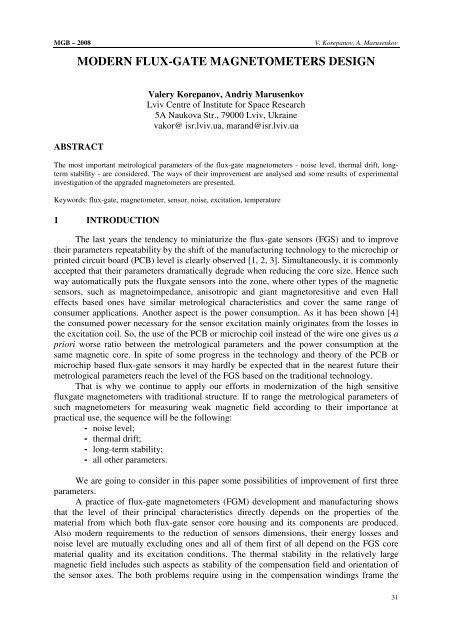
![program_db_karpo.godina_2012.pdf[618.04 KB]](https://img.yumpu.com/50066328/1/184x260/program-db-karpogodina-2012pdf61804-kb.jpg?quality=85)


